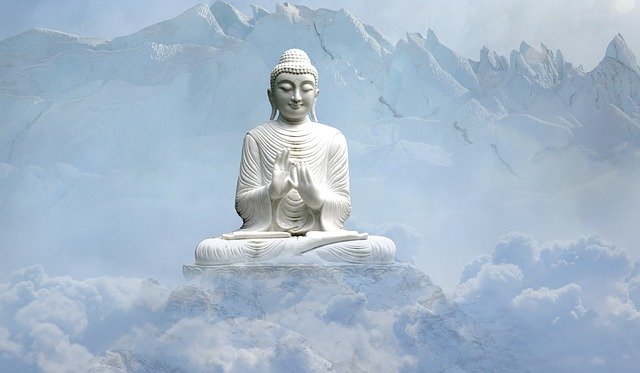A Short Meditation Instruction
Sit down comfortably. You can sit cross-legged on the floor or even on a chair. Put your right hand on top of the left hand on your lap. Right leg is on top of the left leg. Your back should be straight.
Make clear in your mind that you are sitting in meditation now. You try to let go of everything in your mind. All thoughts, problems and worries of your everyday life, now you let them go.
Breathe in deep and breathe out. While breathing out think that you breathe out all thoughts, worries and problems, you let them go.
Close your eyes gently and bring your attention to your abdomen. You will see when you breathe in, then the abdomen is rising, when you breathe out, then the abdomen is falling. Try to be with that movement now. Know the rising and falling of the abdomen.
If you cannot see/feel the movement, you can use your right hand and put it on your belly. Then you can also see a very fine movement of your abdomen. If the movement is clear again, bring your hand back to your lap.
Now make a mental note of what you are experiencing. When you see the abdomen rising note in your mind “rising”, when you see the falling movement of your abdomen, note “falling”. “Rising, falling, rising, falling…” be with the movement and note it in your mind.
You will see that the mind doesn’t really like to stay with the object (rising and falling). Never mind, when you realize that you are involved in thoughts again, note that as “thinking, thinking,” two or three times and then let it go and bring your attention back to the movement of the abdomen.
We need a lot of patience. A beginners mind can be compared with a wild horse. If you catch a wild horse and you try to tame it, it doesn’t want to follow your instructions, the horse will jump and run and try every way to escape. Therefore you have to tie it to a tree, and let it jump. Sooner or later it will stop the whole action because it realizes that you do not let it go. Then it will calm down and peacefully eat the grass.
With the mind it’s the same. We tie it to the breath and to the movement of the abdomen. We have never trained it and so it is stubborn and wants to have it its own way. We need to be patient, and every time it tries to escape, we let go of the thoughts and bring the attention back to the main object, to the movement of the abdomen. Sooner or later the mind will calm down.
Sometimes we feel pain in our knees, the back or anywhere else. Then we note it as “pain, pain”, try to let go of it and return to the main object. Sometimes the pain disappears, sometimes it doesn’t. Never mind, try to be patient and stay in the posture until you feel you really cannot bear it anymore and you want to change position now. Then do it mindfully. Note first “pain, pain” then “wanting to change posture” then note “changing, changing” until you are in the new posture. When you are in the new posture look at the pain – is it still there or has it disappeared. So wisdom will arise. You will see impermanence. There was pain and when you changed the posture the pain disappeared and now there is happiness in the mind.
If you are mindful in this way, whenever you change posture, then you practice correctly. You do not interrupt and lose concentration and mindfulnes.
Sometimes you hear noise from the outside. If it disturbs your practice, then make a mental note of it as “hearing, hearing” and then let it go and come back to the abdomen. It doesn’t matter whatever interupts your mindfulnes you use it as your object, that means note it and let it go and return to the main object, which is the movement of the abdomen.
As beginner practice for 20 minutes, later go up to 30, 40, 50 and 60 minutes.
The walking- and standing meditation is also very important. You should actually do it before the sitting meditation. It will calm the mind and give you the energy for the following sitting meditation.
Start therefore with standing. Be aware of the standing posture. Know “standing, standing”, be aware of your head, shoulders, arms, hands, know you hold your left hand with the right hand in front of your belly. Know your straight back and your legs and the sensation that arises there in your feet when they touch the floor.
Know this is “standing, standing”. You can do the standing meditation as long as you do the walking- and sitting meditation, each posture for about 20 minutes in the beginning – up to one hour.
When you decide to do the walking meditation, then open your eyes and start with bringing your right foot forward and make the mental note “right goes thus”, then note “left goes thus” while bringing your left foot forward. Go on like that. Be aware of the movement of your feet. Walk very slowly and mindfully. This walking meditation can be done in many parts of a step. For the beginning this “first part” is enough.
Try to do the walking- and the standing meditation before the sitting meditation. If you have the time try to do each of this postures for 20 minutes a day. If you do not have much time you can also do them for 10 minutes.
Actually the Buddha taught us to do the meditation in four postures: walking, standing, sitting and lying on.
The lying posture is suitable before you go to sleep, or if you are sick and for elder people, who find it hard do the sitting practice. Lay down on one side and watch your breath (the rising and falling of the abdomen) until you fall asleep.
These instructions are very brief, if you need more informations please contact me per E-mail: meditationthailand@yahoo.com or look up our web-site www.meditationthailand.com.



